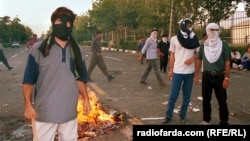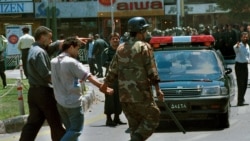Friday July 9, 1999 was the hottest day for students in Tahran as their anti-government protests were met by the iron fist of the Revolutionary Guard. It remained in memories as Iran’s student movement, but it marked a watershed after which disillusionment with the Islamic Republic gradually deepened and the era of popular protests began.
Everything started on July 6 when the Judiciary banned the country's leading reformist daily newspaper Salam, under pressure from the Intelligence Ministry for publishing a confidential letter by its notorious deputy Saeed Emami to the chief of intelligence. Emami was proposing restrictions on media freedoms, including the establishment of a media censorship organization.
He had earlier sent a similar document to Majles, Iran’s Parliament, which was discussing an amendment to the media law when Emami's letter arrived. Deputy Speaker Majid Ansari refused to read out the letter at the podium. However, Salam published the letter the next morning and the Judiciary banned it.
At the time, all the reformist papers published the news of the ban and protested the decision. Nonetheless, the Majles passed Emami's amendment.
Thousands of university students took to the streets of Tehran in protest to the ban on Salam. The daily's managing editor was Mohammad Musavi Khoiniha, the man who called on Supreme Leader Ayatollah Ali Khamenei just two weeks ago to acknowledge his responsibility for the failure of the Islamic Republic.
As the students refused to go back to their classes or the dormitory, things led to violence. Eyewitnesses still remember young men and women in cages mounted on vans being taken to jail.
Police Chief Mohammad Baqer Qalibaf, IRGC's elite commander Qassem Soleimani and 14 other officers wrote a letter to reformist President Mohammad Khatami, warning that they would open fire at the students if they did not stop their protest.
Twenty-one years later, Pro-reform news website Fararu and reformist daily Sharq are among the media outlets that remembered the date on its anniversary. However, both of them did not elaborate on the violence that took place later.
A former journalist at Salam, Morad Vaisi, who currently is a staff journalist at Radio Farda tweeted on the anniversary, "After 21 years, the man who used to beat and suppress the students [Qalibaf] is the Speaker of the Parliament. The one who justified the suppression in a speech [Rouhani] is the President of the country, and the man who ordered the suppression is the Supreme Leader [Khamenei]."
Vaisi further reminded that "those who protested that day were university students, but today's protesters are the residents of 30 of the country's 31 provinces."
The main attack on students took place at a dormitory in Amir Abad Avenue in Tehran. Police and plainclothes thugs attacked the students in the middle of the night and threw some off upper floors. No one counted the wounded or the dead. The thugs set fire to dorm rooms and destroyed the students' belongings.
The courtyard of the dorm was full of bodies dead and alive. The next day, everything was cleared up as if nothing had happened. Reports on state controlled national television portrayed everything as a riot stopped by law and order officers to keep society safe.
President Khatami refused to support the students although some of his advisers say they had told him to do so. Even worse, he branded the protests "An insult to the system and its values." Was this the beginning of an end to the reform movement as everyone knew it? Some say yes it was. Student leaders and many others were put in prison and reformist politicians denied them their support although they were in charge of the government.
Today, almost all the leaders of the 1999 student movement, the biggest show of dissent in the history of the Islamic Republic to that date, are living in exile in London, Washington, Paris and other European and U.S. cities. Some are so disillusioned that they wouldn't talk about the anniversary. Nevertheless, many of them are among the most vocal critics of the Islamic Republic.
It took another 10 years before the next generation of unhappy students took to the streets in 2009 as the Green Movement in protest to an elaborately rigged presidential election. That movement did not make it anywhere either. It lacked proper organization and leadership. The leaders of the movement were two candidates who had lost the election. Today they are under a decade-long house arrest, but many criticize them for turning a blind eye to political murders and unjustifiable violence in the early years of the Islamic revolution.
The student movement is nowhere to be seen. The protests in 2018 and 2019 was faceless in the sense that they had no figurehead. Students, workers, women and all other politically active groups were present in those massive protests. Does this mean that the government has effectively cracked down on the student movement?
In Iran, they say it is fire under the ashes. Still burning without a glow. Those who were active in 1999, desperately wish to be remembered.
"Remember us as 22 year-olds
Who died with the flames of love in our red hearts,
Before finding the time to fall in love."








